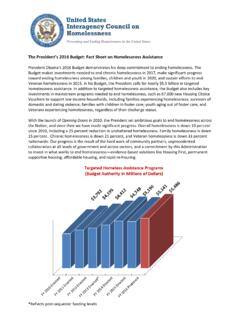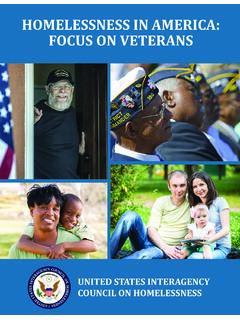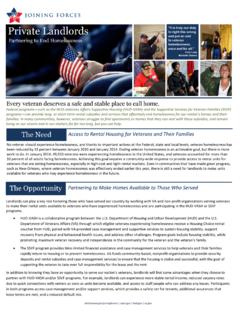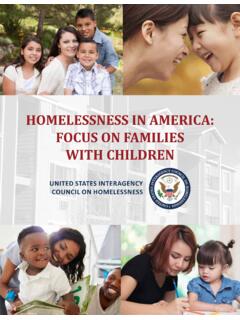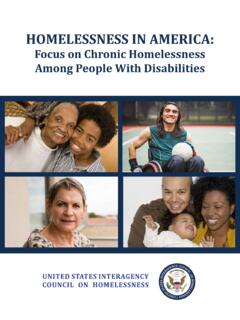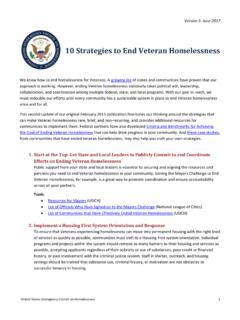Transcription of Strategies to Address the Intersection of the Opioid ...
1 February 2017 United States Interagency Council on Homelessness 1 Strategies to Address the Intersection of the Opioid Crisis and Homelessness Leaders in rural, suburban, and urban communities across the country are grappling with the effects of a worsening Opioid crisis, which may also be contributing to rates of homelessness in some communities. Addressing the challenges can be particularly difficult when community members are suffering from Opioid use disorders (OUDs) and experiencing homelessness at the same time. We know that connecting people experiencing homelessness to safe and stable housing through a Housing First approach can improve their ability to Address their health and behavioral health challenges, including substance use disorders.
2 To support that work, there are a host of new resources being deployed to help communities specifically combat OUDs and Opioid misuse . This document identifies Strategies that communities, providers, and policymakers can use to Address the Intersection of homelessness and the Opioid crisis and highlights resources developed by federal and national partners to support such efforts. Background Last year, the Office of the Surgeon General released Facing Addiction in America: The Surgeon General s Report on Alcohol, Drugs, and Health. The comprehensive report provides an in-depth overview of the science of substance use disorders and addiction, and describes the evidence behind effective prevention , treatment, and recovery policies.
3 For example, behavioral counseling, pharmacologic interventions such as buprenorphine for Opioid misuse , and mutual aid groups have all been shown effective in reducing, treating, and sustaining recovery from substance misuse and substance use disorders. While the research shows that there are many paths to recovery, it is also clear that safe and stable housing plays a key role in supporting people s journey. The five Strategies outlined below can be used by communities as they assess the scope of the issue, seek to build partnerships with necessary services and providers, and work to leverage best practices and evidence-based programs to strengthen their response to the Opioid crisis among people experiencing homelessness.
4 You might also consider exploring the following resources: The 2016 National Alliance to End Homelessness brief, Opioid Abuse and Homelessness, lays out some pertinent research and data. The National Health Care for the Homeless Council has developed a series of webinars highlighting challenges and opportunities in serving individuals experiencing homelessness with Opioid use disorders, best practices, addiction and trauma, and policy. The Department of Justice s Bureau of Justice Assistance developed a clearinghouse of resources to support law enforcement agencies in establishing naloxone programs to prevent lethal Opioid overdoses.
5 The Law Enforcement Naloxone Toolkit includes answers to frequently asked questions February 2017 United States Interagency Council on Homelessness 2 about naloxone, templates, data collection forms, standard operating procedures, training materials, community outreach materials, and other helpful resources. 1. Assess the Prevalence of OUDs and Opioid misuse Among Individuals Experiencing Homelessness Communities grappling with the Opioid crisis among individuals experiencing homelessness can convene local stakeholders to better understand the scope and complexities of the issue locally.
6 Communities should consider engaging peers, representatives from homelessness assistance and housing programs, law enforcement, emergency services, and others who may be familiar with the crisis and who may be able to provide insight into the assessment and planning process. It is also important to engage front-line responders, emergency and longer-term health services, and homelessness outreach teams in overdose response planning to identify and map the Strategies necessary to build or strengthen a shared, community-wide response. Stakeholders should consider the following questions: What trends have providers and community members seen in Opioid abuse among individuals experiencing homelessness?
7 Are there trends related to specific drugs, locations where they are distributed or used, frequency of use, or particular groups who are distributing or using that should inform the selection of the most effective Strategies for engagement and treatment? Can an assessment of those trends be used to improve current outreach and engagement Strategies ? Are there additional health care, supportive services, and housing providers that can be engaged to assist individuals who have Opioid use disorders who are also experiencing homelessness? What health and housing resources could be adapted or expanded to better serve these individuals?
8 What opportunities are there to expand the accessibility of naloxone in the community to prevent lethal Opioid overdoses from occurring? 2. Develop and Implement Overdose prevention and Response Strategies Access to naloxone, a medication that is used to counter Opioid overdoses, should be a critical component of community plans. Maximizing the number of housing providers, emergency services, health care providers, and others who are frequently engaged with individuals experiencing homelessness who have access to naloxone should be a key strategy to turn the tide on lethal Opioid overdoses.
9 According to the Prescription Drug Abuse Policy System, 40 states have laws that allow for naloxone to be dispensed based on standing orders and 41 states allow for third parties to receive a prescription, allowing for caregivers or community members to be equipped should they witness an overdose. In addition to local planning, states and communities also have access to several federal funding resources that can support their efforts. As mandated by the 21st Century Cures Act, the Substance Abuse and Mental Health Services Administration (SAMHSA) released a funding opportunity announcement for State Targeted Response to the Opioid Crisis Grants.
10 The program aims to Address the Opioid crisis by increasing access to treatment, reducing unmet treatment need, and reducing Opioid overdose-related deaths through the provision of prevention , treatment, and recovery activities for Opioid use disorder, including prescription opioids as well as illicit drugs such as heroin. These grants will be awarded to states and territories via a formula based on unmet need for Opioid use disorder treatment and drug poisoning deaths. February 2017 United States Interagency Council on Homelessness 3 SAMHSA s Overdose prevention Toolkit is designed to equip health care providers, communities, and local governments with materials to develop practices and policies to help prevent Opioid -related overdoses and deaths.
